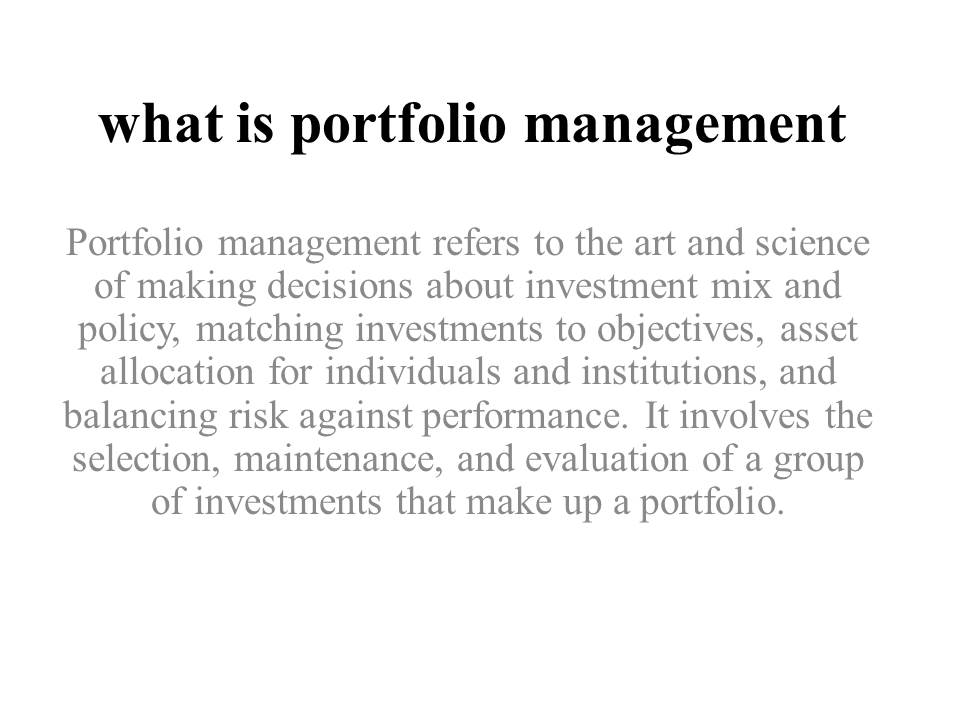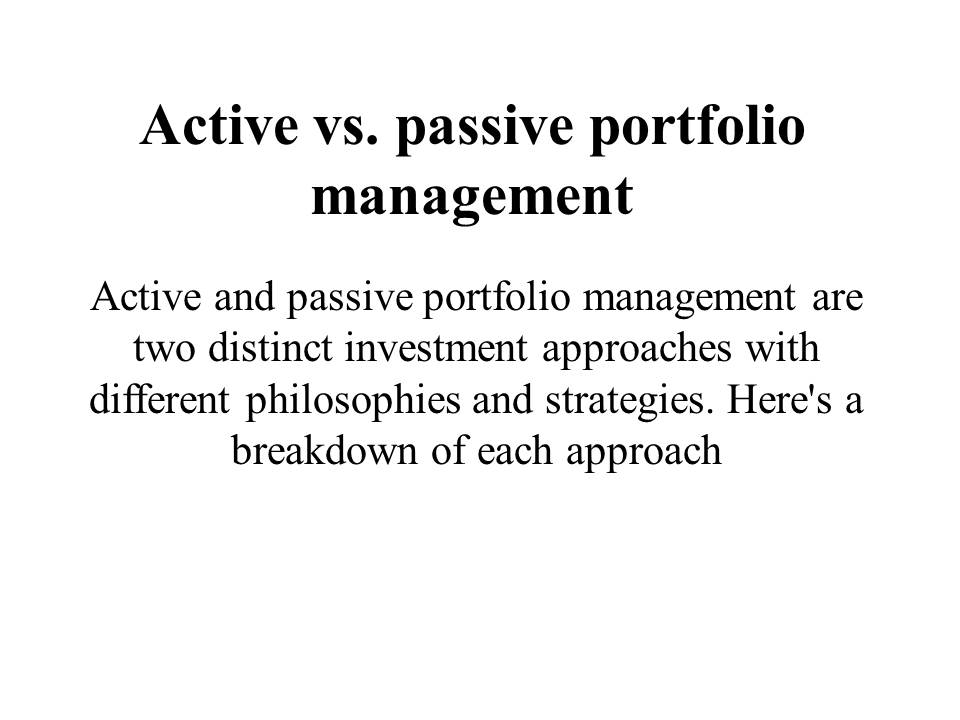what is portfolio management
Portfolio management refers to the art and science of making decisions about investment mix and policy, matching investments to objectives, asset allocation for individuals and institutions, and balancing risk against performance. It involves the selection, maintenance, and evaluation of a group of investments that make up a portfolio.
Here are some key components and concepts related to portfolio management:
- Asset Allocation: This is one of the most critical aspects of portfolio management. It involves determining how to distribute your investments among various asset classes like stocks, bonds, real estate, and cash. The goal is to create a diversified portfolio that can potentially provide better risk-adjusted returns.
- Risk Management: Portfolio managers assess and manage risk. They consider factors such as the investor’s risk tolerance, time horizon, and financial goals to construct a portfolio that aligns with these parameters. Risk management can also involve hedging strategies to protect against potential losses.
- Security Selection: Once asset allocation is decided, portfolio managers choose specific investments (e.g., individual stocks or bonds) to include in the portfolio. They conduct research, analyze financial statements, and evaluate various investment options to make informed decisions.
- Performance Monitoring: Portfolio managers continuously monitor the performance of the investments within the portfolio. They track returns, assess risk levels, and make adjustments as needed to ensure the portfolio aligns with the investor’s objectives.
- Diversification: Diversification is a key strategy to spread risk in a portfolio. By holding a mix of assets that have a low correlation with each other, the impact of a poor-performing asset on the overall portfolio can be minimized.
- Rebalancing: Over time, the performance of different assets in a portfolio can cause the asset allocation to drift from the original target. Portfolio managers periodically rebalance the portfolio by buying and selling assets to bring it back in line with the desired allocation.
- Tax Efficiency: Portfolio managers may also consider tax implications when making investment decisions. They aim to minimize tax liabilities by employing tax-efficient investment strategies.
- Cost Management: Reducing investment costs, such as management fees and trading expenses, can have a significant impact on overall returns. Portfolio managers seek to manage these costs effectively.
- Active vs. Passive Management: Portfolio management can be active, where managers actively make decisions to outperform the market, or passive, where managers aim to replicate the performance of a specific market index. Both approaches have their advantages and drawbacks, and investors can choose based on their preferences and goals.
- Client Communication: For institutional portfolio managers or financial advisors working with individual clients, effective communication is crucial. Clients need to understand how their investments are performing and whether any adjustments are necessary based on changing circumstances.
In summary, portfolio management involves the strategic and ongoing process of constructing and maintaining an investment portfolio that aligns with an individual’s or institution’s financial goals, risk tolerance, and time horizon while optimizing returns and minimizing risk. It’s a dynamic field that requires a deep understanding of financial markets, investment instruments, and risk management techniques.

Active vs. passive portfolio management
Active and passive portfolio management are two distinct investment approaches with different philosophies and strategies. Here’s a breakdown of each approach:
Active Portfolio Management:
- Philosophy: Active portfolio management believes in actively making investment decisions with the goal of outperforming a specified benchmark or index. The underlying belief is that skilled portfolio managers or investment professionals can identify mispriced securities or make tactical asset allocation decisions to generate superior returns.
- Investment Selection: Active managers conduct in-depth research and analysis to select individual securities or assets they believe will outperform the market. They may also make frequent adjustments to the portfolio based on changing market conditions, economic forecasts, or company-specific factors.
- Costs: Active management typically involves higher costs due to research expenses, trading costs, and management fees. Investors pay these fees in exchange for the potential to outperform the market.
- Risk: While active management aims for outperformance, it also carries the risk of underperformance. The success of active managers depends on their skill and ability to make accurate predictions, and not all active managers consistently beat their benchmarks.
- Examples: Actively managed mutual funds and hedge funds are common examples of active portfolio management strategies.
Passive Portfolio Management:
- Philosophy: Passive portfolio management, also known as index investing, follows the belief that it’s challenging to consistently beat the market over the long term. Instead, it seeks to replicate the performance of a specific benchmark or index. The primary goal is to match the returns of the chosen index rather than outperform it.
- Investment Selection: Passive managers aim to replicate the composition of a benchmark or index by holding a diversified portfolio of securities that mimic the index. These portfolios require less active decision-making, as they follow a predefined strategy.
- Costs: Passive management tends to have lower costs compared to active management. This is because there is less need for extensive research and trading. As a result, passive investments often have lower management fees.
- Risk: Passive management seeks to match the benchmark’s performance, so the risk typically mirrors that of the benchmark. There is no attempt to outperform, which can be seen as a lower-risk approach.
- Examples: Exchange-Traded Funds (ETFs) and index mutual funds are common examples of passive portfolio management strategies. These funds aim to replicate the performance of specific indices like the S&P 500 or the FTSE 100.
Key Considerations:
- Performance: Active management aims for outperformance but comes with the risk of underperformance. Passive management seeks to match benchmark returns.
- Costs: Active management is typically associated with higher costs, while passive management is known for its cost-efficiency.
- Risk: Active management may involve higher risk due to the potential for significant deviations from the benchmark. Passive management aims to minimize active risk.
- Investor Preferences: The choice between active and passive management often depends on individual investor preferences, risk tolerance, and belief in the ability of active managers to consistently outperform the market.
- Market Conditions: Market conditions can influence the relative performance of active and passive strategies. In some market environments, active managers may excel, while in others, passive strategies may shine.
Ultimately, the decision between active and passive portfolio management should align with an investor’s financial goals, risk tolerance, and investment philosophy. Some investors may choose a combination of both approaches to achieve a balanced investment strategy.

Active Portfolio Management
Portfolio management vs. wealth management
Portfolio management and wealth management are related but distinct financial services that focus on different aspects of an individual’s or an institution’s financial well-being. Here’s a comparison of these two terms:
Portfolio Management:
- Focus: Portfolio management primarily revolves around the management of an investment portfolio. It is primarily concerned with making investment decisions to achieve specific financial goals while optimizing returns and managing risk within the portfolio.
- Scope: The scope of portfolio management is narrower and more specialized. It involves activities such as asset allocation, security selection, risk management, and performance monitoring for the investments held within a portfolio.
- Service Provider: Portfolio management services can be provided by portfolio managers, investment advisors, or asset management firms. These professionals are responsible for making investment decisions on behalf of their clients.
- Objectives: The primary objective of portfolio management is to grow the value of the assets within the portfolio. It may involve strategies like diversification, asset allocation, and active or passive management to achieve this goal.
- Key Activities: Key activities in portfolio management include selecting individual securities or assets, periodic rebalancing to maintain the desired asset allocation, monitoring performance, and implementing risk management strategies.
- Client Involvement: Clients working with portfolio managers often have a more hands-off approach, entrusting the management of their investments to professionals.
Wealth Management:
- Focus: Wealth management takes a broader view of an individual’s or family’s financial situation. It encompasses not only investment management but also financial planning, estate planning, tax optimization, retirement planning, and more.
- Scope: The scope of wealth management is comprehensive, considering all aspects of a client’s financial life. This includes managing investments but also addressing broader financial goals and challenges.
- Service Provider: Wealth management services are typically offered by wealth management firms or financial advisors who provide holistic financial advice and solutions. These advisors take into account various financial planning aspects, not just investments.
- Objectives: While growing wealth is a part of wealth management, the primary focus is on helping clients achieve their financial goals across different life stages. This can include buying a home, saving for education, planning for retirement, and transferring wealth to heirs.
- Key Activities: Key activities in wealth management encompass investment management, financial planning, tax optimization, estate planning, retirement planning, risk management, and more. It involves creating a customized financial plan that aligns with a client’s specific objectives.
- Client Involvement: Wealth management often requires close collaboration between the client and the advisor. Clients actively participate in setting financial goals, discussing strategies, and making decisions related to various aspects of their financial plan.
Summary:
In summary, while both portfolio management and wealth management involve managing assets and investments, they differ in scope and objectives. Portfolio management is primarily concerned with optimizing the performance of an investment portfolio, while wealth management takes a holistic approach, addressing a client’s broader financial needs and goals. Wealth management encompasses financial planning, tax optimization, estate planning, and more, making it a comprehensive and client-focused service.
Top of Form
Top of Form
Top of Form
